Sony SNCA-CFW5 Handleiding
Sony
Niet gecategoriseerd
SNCA-CFW5
Bekijk gratis de handleiding van Sony SNCA-CFW5 (2 pagina’s), behorend tot de categorie Niet gecategoriseerd. Deze gids werd als nuttig beoordeeld door 19 mensen en kreeg gemiddeld 4.5 sterren uit 10 reviews. Heb je een vraag over Sony SNCA-CFW5 of wil je andere gebruikers van dit product iets vragen? Stel een vraag
Pagina 1/2

3-218-128-02 (1)
Wireless Card
取扱説明書
お買い上げいただきありがとうございます。
電気製品は、安全のための注意事項を守らないと、けが
をしたり周辺の物品に損害を与えることがあります。
この取扱説明書には、事故を防ぐための重要な注意事項と製品の取り
扱いかたを示しています。 、製品この取扱説明書をよくお読みのうえ
を安全にお使いください。お読みになったあとは、いつでも見られる
ところに必ず保管してください。
Operating Instructions
Mode d’emploi
Manual de instrucciones
Bedienungsanleitung
Istruzioni per l’uso
SNCA-CFW5
2007 Sony Corporation Printed in China
日本語
安全のために
ソニー製品は正しく使用すれば事故が起きないように、安全には充分
配慮して設計されています。しかし、電気製品は、まちがった使いか
たをすると、火災や感電などにより死亡や大けがなど人身事故につな
がることがあり、危険です。
事故を防ぐために次のことを必ずお守りください。
•
安全のための注意事項を守る。
•
長期間、安全にお使いいただくために、定期点検をすることをおすす
めします。点検の内容や費用については、お買い上げ店またはソニー
の相談窓口に相談する。
•
破損したら使わずに、お買い上げ店またはソニーの相談窓口に修理を
依頼する。
行為を禁止する記号
行為を指示する記号
警告表示の意味
この取扱説明書および製品では、次の
ような表示をしています。表示の内容
をよく理解してから本文をお読みくだ
さい。
この表示の注意事項を守らないと、感電
やその他の事故により をしたり周けが
辺の物品に を与えたりすることが損害
あります。
下記の注意事項を守らないと、けがをしたり
周辺の物品に
損害を与えることがあります。
分解や改造をしない
分解や改造をすると、火災や感電、けがの原因となるこ
とがあります。
内部の点検や修理は、お買い上げ店またはソニーの相
談窓口にご依頼ください。
直射日光に当たる場所、熱器具の近くには置かない
変形したり、故障したりするだけでなく、カメラのレン
ズの特性により火災の原因となることがあります。特
に、窓際に置くときなどはご注意ください。
水にぬれる場所で使用しない
水ぬれすると、漏電による感電、発火の原因となること
があります。
指定された電源電圧で使用する
指定されたものと異なる電源電圧で使用すると、火災
や感電の原因となります。
機器や部品の取り付けは正しく行う
機器や部品の取り付け方や、本機の分離・合体の方法を
誤ると、本機や部品が落下して、けがの原因となること
があります。
取扱説明書に記載されている方法に従って、確実に
行ってください。
内部に水や異物を入れない
水や異物が入ると、火災の原因となります。
万一、水や異物が入ったときは、すぐに本機が接続され
ている電源供給機器の電源コードや
DC
電源ケーブル、
本機の接続ケーブルを抜いて、お買い上げ店またはソ
ニーの相談窓口にご相談ください。
雨のあたる場所や、油煙、湯気、湿気、ほこりの多い場
所には設置しない
上記のような場所やこの取扱説明書に記されている仕
様条件以外の環境に設置すると、火災や感電の原因と
なることがあります。
心臓ペースメーカーの装着部位から
22cm
以内で使
用しない
電波によりペースメーカーの動作に影響を与えるおそ
れがあります。
機器設定について
本機は、電波法に基づく小電力データ通信システムの無線設備として、
認証を受けています。従って、本機を使用するときに無線局の免許は必
要ありません。
認証機器名は次のとおりです。
認証機器名:
SNCA-CFW5
ただし、以下の事項を行うと法律に罰せられることがあります。
•
本機を分解
/
改造すること
•
本機の裏面にある証明番号を消すこと
ワイヤレス
LAN
製品ご使用時におけるセキュリティについて
ワイヤレス
LAN
ではセキュリティの設定をすることが非常に重要です。
セキュリティ対策を施さず、あるいはワイヤレス
LAN
の仕様上やむを得
ない事情により、セキュリティの問題が発生してしまった場合、弊社で
はこれによって生じたあらゆる損害に対する責任を負いかねます。
周波数について
本機は
2.4GHz
帯の無線チャンネル
1
から
11
まで使用することができます
が、他の無線機器も同じ周波数を使っていることがあります。他の無線機器
との電波干渉を防止するため、下記事項に注意してご使用ください。
本機の使用上の注意
本機の使用周波数は
2.4GHz
帯です。この周波数帯では電子レンジ等の産
業・科学・医療用機器のほか、他の同種無線局、工場の製造ライン等で使
用される免許を要する移動体識別用構内無線局、免許を要しない特定の小
電力無線局、アマチュア無線局等(以下「他の無線局」と略す)が運用されて
います。
1.
本機を使用する前に、近くで「他の無線局」が運用されていないことを
確認してください。
2.
万一、本機と「他の無線局」との間に電波干渉が発生した場合には、速
やかに本機の使用チャンネルを変更するか、使用場所を変えるか、ま
たは機器の運用を停止(電波の発射を停止)してください。
3.
不明な点その他お困りのことが起きたときは、お買い上げ店またはお近
くのソニーの相談窓口までお問い合わせください。
この無線機器は
2.4GHz
帯を使用します。変調
方式として
DS-SS
変調方式および
OFDM
変調方
式を採用し、与干渉距離は
40m
です。
万一、製造上の原因による不良がありましたらお取り替えいたします。
それ以外の責はご容赦ください。
2.4 DS/OF 4
概要
ソニーワイヤレスカード
SNCA-CFW5
を使うと、ワイヤレスで通信可
能な範囲であれば、ネットワークカメラを
LAN
に接続できます。また、
他の人が
LAN
に接続中でもネットワークを使用できます。
本機は、ソニーネットワークカメラ専用です。ラップトップコンピュー
ターや、デスクトップコンピューター、
PDA
やその他の周辺機器に入れ
ても正しく動作しません。
また、本機のアンテナジャックに外部アンテナを接続すると、通信距離
を伸ばすことができます。
本機を使用する場合のカメラの設定のしかたや操作方法について詳しく
は、ネットワークカメラに付属のユーザーガイドをご覧ください。
使用上のご注意
本機の取り扱いについて
•衝撃を加えたり、落としたりしないでください。本機の故障の原因と
なります。
•直射日光が当たる場所、暖房器具の近くなど、異常な高温になる場所
には置かないでください。故障の原因となることがあります。
•クリップなどの金属物を本機の中に入れないでください。
•振動する場所や不安定な場所では使用しないでください。
•ほこりが多い場所では使用しないでください。
•湿気が多い場所では使用しないでください。
•風通しが悪い場所では使用しないでください。
•本機をカメラに取り付けるときは、取り付ける向きに注意してくださ
い。無理に押し込むと故障の原因となります。
•
2.4GHz
帯を使用する機器が周囲にある場合,本機およびカメラが
正常に動作しない恐れがありますのでご注意ください。また使用環
境の影響により、電波が届かないもしくは接続が不安定になる場合
があります。
•お使いになる前に、必ず動作確認を行ってください。故障その他に
伴う営業上の機会損失等は保証期間中および保証期間経過後にかか
わらず、補償はいたしかねますのでご了承ください。
•本製品の使用によりデータが消失した場合でも、データの保証は一
切いたしかねます。
結露について
結露とは空気中の水分が金属の板などに付着し、水滴となる現象です。本
機を寒い場所から急に暖かい場所に持ち込んだときや、冬の朝など暖房を
入れたばかりの部屋などで本機の表面や内部に結露が起こることがありま
す。そのままご使用になると故障の原因となります。結露が起きたとき
は、結露がなくなるまで電源を入れずに放置してください。
各部の名称と働き
表面 A
1リンクインジケーター
カードの初期化およびネットワークへの接続動作中は点滅し、ネット
ワークへの接続が完了すると点灯に変わります。
2アンテナジャック
別売りのアンテナ
SNCA-AN1
のプラグを接続します。
裏面 B
3
MAC
アドレスおよびシリアル番号
MAC: XXXXXX-XXXXXX
本機の
MAC
アドレスです。
SN: XXXXXXX
本機の製造番号です。
本機をカメラに挿入する
ネットワークカメラの
C F
カードスロット、または市販の
CompactFlash type II-PCMCIA
変換アダプターを使用し
PC
カード
スロットに本機を挿入します。
ご注意
•カードスロットにまっすぐに奥まで差し込んでください。
•正しい向きに差し込んでください。逆向きに無理に押し込むと破損により
故障の原因となります。
•ネットワークカメラが本機の認識に失敗した場合は、挿入しなおしてくだ
さい。
•通信中は本機を取り外したり、本機に衝撃を与えたりしないでください。
本機をカメラから取り外すには
使い終わったら、通信状態を終了し、まっすぐに引き出すようにして取
り外してください。
主な仕様
絶対的最大条件
電源 −
0.3
〜
3.6 V
(最大)
保存温度 −
25
〜
+
60
℃
(表示の温度はセットの周囲の温度を表していま
す。)
動作条件
電源
3.0
〜
3.6 V
(最大)
動作温度 −
20
〜
+
60
℃
電気的性能
消費電流 最大
380 mA
(送信時)
中心周波数帯
2412
〜
2462 MHz
(チャンネル
1
〜
11
)
アンテナ利得 内蔵アンテナ:最大
0.11 dBi
外部指向性アンテナ:最大
6.4 dBi
(ケーブル損失
2.8 dB
を含む)
送信出力 最大
+
13 dBm
受信感度
802.11b:
−
80 dBm (PER 8e-2
、
11 Mbps)
802.11g:
−
65 dBm (PER 10e-2
、
54 Mbps)
データ速度
802.11b: 11
、
5.5
、
2
、
1 Mbps
802.11g: 54
、
48
、
36
、
24
、
18
、
12
、
9
、
6 Mbps
付属品 取扱説明書
(本書)
(1)
保証書
(冊子)
(1)
本機の仕様および外観は、改良のため予告なく変更されることがあります
が、ご了承ください。
保証書について
•この製品には保証書が添付されていますので、お買い上げの際にお受け
取りください。
•所定事項の記入および記載内容をお確かめのうえ、大切に保存してくだ
さい。
•保証期間は、お買い上げ日より
1
年間です。
A B
2
1
3
English
Owner’s Record
The model and serial numbers are located at the rear.
Record the serial number in the space provided below.
Refer to these numbers whenever you call upon your Sony dealer regarding
this product.
Model No. SNCA-CFW5 Serial No.
For the customers in the U.S.A.
This equipment has been tested and found to comply with the limits for
a Class B digital device, pursuant to Part 15 of the FCC Rules. These
limits are designed to provide reasonable protection against harmful
interference in a residential installation.
This equipment generates, uses, and can radiate radio frequency
energy and, if not installed and used in accordance with the
instructions, may cause harmful interference to radio communications.
However, there is no guarantee that interference will not occur in a
particular installation. If this equipment does cause harmful interference
to radio or television reception, which can be determined by turning the
equipment off and on, the user is encouraged to try to correct the
interference by one or more of the following measures:
– Reorient or relocate the receiving antenna.
– Increase the separation between the equipment and receiver.
– Connect the equipment into an outlet on a circuit different from that to
which the receiver is connected.
– Consult the dealer or an experienced radio/TV technician for help.
If you have any questions about this product, you may call;
Sony Customer Information Service Center 1-800-222-7669 or
http://www.sony.com/
Declaration of Conformity
Trade Name : SONY
Model : SNCA-CFW5
Responsible party : Sony Electronics Inc.
Address : 16530 Via Esprillo, San Diego, CA 92127 U.S.A.
Telephone Number : 858-942-2230
This device complies with part 15 of the FCC Rules. Operation is subject
to the following two conditions: (1) this device may not cause harmful
interference, and (2) this device must accept any interference received,
including interference that may cause undesired operation.
You are cautioned that any changes or modifications not expressly
approved in this manual could void your authority to operate the
equipment.
FCC Radiation Exposure Statement:
This Transmitter must not be co-located or operated in conjunction with any
other antenna or transmitter.
This equipment complies with FCC radiation exposure limits set forth for an
uncontrolled environment. This equipment should be installed and operated
with minimum distance 20 cm between the radiator & your body.
For customers in Canada
This Class B digital apparatus complies with Canadian ICES-003.
Operation is subject to the following two conditions: (1) this device may not
cause interference, and (2) this device must accept any interference,
including interference that may cause undesired operation of the device.
IC Radiation Exposure Statement:
This equipment complies with IC RSS-102 radiation exposure limits set
forth for an uncontrolled environment. This equipment should be installed
and operated with minimum distance 20 cm between the radiator & your
body.
For customers in Europe
Hereby, Sony Corporation, declares that this SNCA-
CFW5/Wireless Card is in compliance with the essential
requirements and other relevant provisions of Directive
1999/5/EC.
For details, please access the follwing URL:
http://www.compliance.sony.de/
Limitation for use in the EU
This device can operate indoors or outdoors in all countries of the European
Community using the 2.4GHz band: Channels 1 - 11, except where noted
below:
• In Italy, usage of the above mentioned device is regulated under Italian
law:
– D. Lgs 1.8.2003, n.259, art. 104 (activity subject to general
authorization) and art. 105 (free usage), and for private usage;
– D.M. 28/5/03, for providing to the general public access to R-LAN
networks and services.
• In France outdoor operation is only permitted using the 2.4 - 2.454 GHz
band: Channels 1 - 7.
Security on using wireless LAN products
Security configuration is essential for wireless LAN. Should a problem occur
without setting security, or due to the limitation of the wireless LAN
specifications, Sony shall not be liable for any damage.
If a problem occurs with this product as a result of defective
manufacturing, Sony will replace it. However, Sony accepts no other
responsibility.
Warnings
• In some situations or environments, the use of IEEE 802.11b/g
technology may be restricted by the proprietor of the building or
responsible representatives of the organization, for example on board of
airplanes, in hospitals or in any other environment where the risk of
interference with other devices or services is perceived or identified as
harmful.
• If you are uncertain about the policy applying to the use of IEEE 802.11b/
g technology in a specific organization or environment, you are
encouraged to seek authorization before switching it on.
• Consult your doctor or the manufacturer of personal medical devices
(pacemakers, hearing aids, etc.) regarding any restrictions on the use of
IEEE 802.11b/g technology.
Introduction
Sony SNCA-CFW5 Wireless Card allows you to connect the Network
Camera to a Local Area Network from anywhere within the wireless
coverage area. It also enables you to roam throughout the network while
remaining connected to the LAN.
This Wireless Card operates only with Sony Network Cameras. It cannot
work properly with Laptop PCs, Desktop PCs, PDAs or other peripherals.
The Wireless Card has an external antenna jack. The external antenna can
expand communication distance.
For details on the settings and operations of the camera for using the card,
refer to the User's Guide supplied with the camera.
Precautions on Use
Handling the Wireless Card
• Do not subject the card to excessive shock, and take care not to drop it to
prevent malfunction.
• Do not use or store the card in locations subject to:
– extremely high temperature, such as in direct sunlight or near a heater
– excessive dust
– high humidity
– vibrations
– poor ventilation
This may cause a malfunction.
• Do not put a metal object such as a metal clip, etc. inside the card.
• Do not use the card in an unstable place.
• When inserting the card into the camera, take care not to force it in the
wrong way. This may cause a malfunction.
• When there is a device operating on the 2.4 GHz frequency band near
the camera, the card and camera may not work correctly. The radio wave
may go out of service or a poor connection may occur sometimes
depending on the environment.
• Always verify that the unit is operating properly before use. SONY WILL
NOT BE LIABLE FOR DAMAGES OF ANY KIND INCLUDING, BUT NOT
LIMITED TO, COMPENSATION OR REIMBURSEMENT ON ACCOUNT
OF THE LOSS OF PRESENT OR PROSPECTIVE PROFITS DUE TO
FAILURE OF THIS UNIT, EITHER DURING THE WARRANTY PERIOD
OR AFTER EXPIRATION OF THE WARRANTY, OR FOR ANY OTHER
REASON WHATSOEVER.
• If you lose data by using the Wireless Card, Sony accepts no
responsibility for restoration of the data.
Condensation
Condensation is a phenomenon that occurs when moisture in the air turns
into drops of water when it comes into contact with a metal plate, for
example. Condensation may occur on the surface or inside the Wireless
Card when you quickly move it from a cold place to a warm place, or when
you turn on the heating in the room on a cold, winter morning. Using the
Wireless Card with condensation on it may cause a malfunction. If
condensation occurs on the Wireless Card, leave it without turning on the
power of the camera until the condensation disappears.
Location and Function of Parts
Front A
1Link indicator
Flashes while the card is being initialized or the camera is being
connected to the network.
Remains lit when the connection to the network is established.
2Antenna jack
Connect the plug of the optional SNCA-AN1 antenna.
Rear B
3MAC address and Serial number
MAC: XXXXXX-XXXXXX Indicates the MAC address of this card.
SN: XXXXXXX Indicates the serial number of this card.
Inserting the Wireless Card into the Camera
Insert the Wireless Card into the CF card slot on the camera or insert it
in a commercially available CompactFlash type II-PCMCIA adapter and
then to the PC card slot of the camera.
Notes
• Insert the Wireless Card straight and fully into the card slot on the
camera.
• Do not insert the Wireless Card the wrong way. Forcing it in the
wrong way will damage it and cause a malfunction.
• If the camera failed to identify the Wireless Card, remove the card
from the camera and insert it again.
• During communication, do not remove the Wireless Card or
subject the camera to excessive shock.
Removing the Wireless Card
After use, stop all communication. Then, pull the Wireless Card straight
out.
Specifications
Absolute maximum ratings
Supply voltage –0.3 to 3.6 V (max.)
Storage temperature –25 to +60 C (–13 to +140 F)° °
(All temperature references refer to ambient conditions)
Operating conditions
Supply voltage range 3.0 to 3.6 V (max.)
Temperature range –20 to +60 C (–4 to +140 F)° °
Electrical Specifications
Current consumption 380 mA max. (In transmission)
Center frequency range 2412 to 2462 MHz (1-11ch)
Antenna Gain Internal: 0.11 dBi max.
External-polarity: 6.4 dBi max. (Including
cable loss 2.8 dB)
Transmitter power +13 dBm max.
Receiving sensitivity 802.11b: –80 dBm (PER 8e-2, at 11 Mbps)
802.11g: –65 dBm (PER 10e-2, at 54
Mbps)
Data rate 802.11b: 11, 5.5, 2, 1 Mbps
802.11g: 54, 48, 36, 24, 18, 12, 9, 6 Mbps
Supplied accessory Operating Instructions (this document) (1)
Design and specifications are subject to change without notice.
Français
Pour les utilisateurs au Canada
Cet appareil numérique de la classe B est conforme à la norme NMB-
003 du Canada.
L’utilisation doit répondre aux deux conditions suivantes : (1) ce
matériel ne doit pas provoquer de brouillage et (2) il doit accepter tout
brouillage, même celui qui est susceptible d’affecter son
fonctionnement.
Déclaration d’exposition aux radiations des IC :
Cet appareil est conforme aux limites d’exposition aux radiations des IC
RSS-102 établies pour un environnement non contrôlé. Pour
l’installation et l’utilisation de cet appareil, il convient de prévoir une
distance minimum de 20 cm entre le radiateur et votre corps.
Pour les utilisateurs en Europe
Par la présente Sony Corporation déclare que
l’appareil SNCA-CFW5/Wireless Card est conforme
aux exigences essentielles et aux autres dispositions
pertinentes de la directive 1999/5/CE.
Pour toute information complémentaire, veuillez consulter l’URL
suivante:
http://www.compliance.sony.de/
Restriction d’utilisation au sein de l’Union européenne
Cet appareil peut être utilisé à l’intérieur ou à l’extérieur dans tous les
pays de la Communauté européenne en utilisant la bande de
fréquences 2,4 GHz : canaux 1 à 11, à l’exception des endroits
mentionnés ci-dessous :
En France, l’utilisation à l’extérieur est autorisée uniquement si vous
utilisez la bande de fréquences 2,4 à 2,454 GHz : canaux 1 à 7.
Précautions de sécurité lors de l’utilisation de produits
LAN sans fil
La configuration de la sécurité est essentielle à une utilisation correcte
des produits LAN sans fil. Si un problème se produit sans que vous
ayez activé la sécurité ou en raison de la limitation des spécifications
LAN sans fil, Sony ne pourra être tenue responsable de quelque
dommage que ce soit.
Si vous rencontriez un problème avec cet appareil en raison d’un
défaut de fabrication, Sony le remplacera. Toutefois, Sony
n’assume aucune autre responsabilité.
Avertissements
• Dans certaines situations ou environnements, l’utilisation de la
technologie IEEE 802.11b/g peut être limitée par le propriétaire du
bâtiment ou les représentants responsables de l’organisation, par
exemple à bord d’un avion, dans les hôpitaux ou dans tout autre
environnement où le risque d’interférence avec d’autres appareils ou
services est considéré ou identifié comme nuisible.
• Si vous hésitez quant à la politique à adopter pour l’utilisation de la
technologie IEEE 802.11b/g dans une organisation ou un
environnement spécifique, nous vous conseillons d’obtenir toutes les
autorisations nécessaires avant toute mise en route.
• Consultez votre médecin ou le fabricant d’appareils médicaux
personnels (stimulateurs cardiaques, prothèses auditives, etc.)
concernant les restrictions d’utilisation de la technologie IEEE
802.11b/g.
Introduction
La carte sans fil Sony SNCA-CFW5 vous permet de raccorder la
caméra réseau à un réseau local (LAN) où que vous vous trouviez dans
la zone de couverture sans fil. Elle vous permet également de vous
déplacer dans le réseau tout en restant connecté au LAN.
Cette carte sans fil fonctionne exclusivement avec les caméras réseau
Sony. Les ordinateurs portables, de bureau, PDA ou autres
périphériques ne peuvent pas fonctionner correctement avec cet
appareil.
La carte sans fil dispose d’une prise d’antenne externe. L’antenne
externe peut augmenter la distance de communication.
Pour obtenir plus de détails sur les réglages et le fonctionnement de la
caméra avec la carte, reportez-vous au mode d’emploi fourni avec la
caméra
(suite au verso)

Précautions d’utilisation
Manipulation de la carte sans fil
• Ne soumettez pas la carte à des chocs excessifs et veillez à ne pas
la laisser tomber afin d’éviter tout problème de fonctionnement.
• N’utilisez pas ou ne rangez pas la carte dans des endroits exposés
à :
– des températures très élevées, comme à la lumière directe du soleil
ou à proximité d’un radiateur,
– une poussière excessive,
– une humidité élevée,
– des vibrations,
– une ventilation insuffisante.
Ceci risque de provoquer un problème de fonctionnement.
• N’insérez pas d’objet métallique comme une pince en métal, etc. à
l’intérieur de la carte.
• N’utilisez pas la carte dans un endroit instable.
• Lorsque vous insérez la carte dans la caméra, ne l’introduisez pas à
l’envers en forçant. Ceci risque de provoquer un problème de
fonctionnement.
• Si un appareil fonctionne sur une bande de fréquences de 2,4 GHz à
proximité de la caméra, il est possible que la carte et la caméra ne
fonctionnent pas correctement. En fonction de l’environnement, il se
peut que les ondes radio ne soient pas captées ou que la connexion
soit de mauvaise qualité.
• Vérifiez toujours que l'appareil fonctionne correctement avant
l'utilisation. Sony n'assumera pas de responsabilité pour les
dommages de quelque sorte qu'ils soient, incluant mais ne se
limitant pas à la compensation ou au remboursement, à cause
de la perte de profits actuels ou futurs suite à la défaillance de
cet appareil, que ce soit pendant la période de garantie ou après
son expiration, ou pour toute autre raison quelle qu'elle soit.
• Sony décline toute responsabilité en cas de perte de données lors de
l’utilisation de la carte sans fil.
Condensation
La condensation est un phénomène qui se produit lorsque l’humidité de
l’air se transforme en gouttelettes d’eau au contact d’une plaque
métallique, par exemple. La condensation peut se produire à la surface
ou à l’intérieur de la carte sans fil lorsque vous la déplacez rapidement
d’un endroit froid à un endroit chaud ou lorsque vous allumez le
chauffage dans un endroit froid, un matin d’hiver. Si vous utilisez la
carte sans fil alors que de la condensation s’est formée dessus, elle
risque de fonctionner de façon incorrecte. Si de la condensation se
produit sur la carte sans fil, laissez-la sans mettre la caméra sous
tension, jusqu’à ce que la condensation disparaisse.
Emplacement et fonctionnement des
pièces et des commandes
Avant A
1Témoin de liaison
Clignote pendant l’initialisation de la carte ou lorsque la caméra est en
cours de connexion avec le réseau.
Reste allumé lorsque la connexion au réseau est établie.
2Prise d’antenne
Raccordez la fiche de l’antenne SNCA-AN1 en option.
Arrière B
3Adresse MAC et numéro de série
MAC : XXXXXX-XXXXXX Indique l’adresse MAC de cette carte.
N° de série : XXXXXXX Indique le numéro de série de cette carte.
Insertion de la carte sans fil dans la caméra
Insérez la carte sans fil dans l’emplacement pour carte CF de la caméra
ou insérez-la dans un adaptateur CompactFlash de type II-PCMCIA,
puis insérez l’adaptateur dans l’emplacement pour carte PC de la
caméra.
Remarques
• Insérez la carte sans fil bien droite et à fond dans l’emplacement
pour carte de la caméra.
• N’insérez pas la carte sans fil dans le mauvais sens. Si vous
forcez pour l’insérer dans le mauvais sens, vous risquez de
provoquer un mauvais fonctionnement.
• Si la caméra ne parvient pas à identifier la carte sans fil, retirez-la
de la caméra et réinsérez-la à nouveau.
• En cours de communication, ne retirez pas la carte sans fil ou ne
soumettez pas la caméra à des chocs excessifs.
Retrait de la carte sans fil
Après utilisation, interrompez toute communication. Retirez ensuite la
carte sans fil en la tenant bien droite.
Spécifications
Valeurs nominales maximales
Tension d’alimentation – 0,3 à 3,6 V (max.)
Température de stockage –25 à +60 °C (–13 to +140 °F)
(Toutes les références de températures indiquent des conditions
ambiantes)
Conditions de fonctionnement
Plage de tension d’alimentation
3,0 à 3,6 V (max.)
Plage de températures –20 à +60 °C (–4 to +140 °F)
Spécifications électriques
Consommation de courant 380 mA max. (en transmission)
Plage de fréquences centrales
2 412 à 2 462 MHz (1-11 canaux)
Gain de l’antenne Interne : 0,11 dBi max.
Polarité externe : 6,4 dBi max. (y compris la
perte liée au câble de l’ordre de 2,8 dB)
Puissance de transmission +13 dBm max.
Sensibilité de réception 802.11b: –80 dBm (PER 8e-2, à 11 Mbit/s)
802.11g: –65 dBm (PER 10e-2, à 54 Mbit/s)
Vitesse de transmission des données
802.11b : 11, 5,5, 2, 1 Mbit/s
802.11g : 54, 48, 36, 24, 18, 12, 9, 6 Mbit/s
Accessoire fourni Mode d’emploi (ce document) (1)
La conception et les spécifications sont sujettes à modification sans
préavis.
Español
Para los clientes de Europa
Por medio de la presente Sony Corporation declara
que el SNCA-CFW5/Wireless Card cumple con los
requisitos esenciales y cualesquiera otras
disposiciones aplicables o exigibles de la Directiva
1999/5/CE.
Para mayor información, por favor consulte el siguiente URL:
http://www.compliance.sony.de/
Limitaciones de uso en la Unión Europea
Este dispositivo puede utilizarse en interiores o en exteriores en todos
los países de la Comunidad Europea mediante la banda de 2,4 GHz:
canales 1 a 11, excepto en los países que se indican a continuación:
Seguridad en la utilización de productos de LAN
inalámbrica
La configuración de seguridad es muy importante para la LAN
inalámbrica. Sony no se hará responsable de los daños ocasionados
por problemas con los ajustes de seguridad o debidos a la limitación de
las especificaciones de LAN inalámbrica.
Si se produce un problema con este producto debido a un defecto
de fabricación, Sony lo sustituirá. Sin embargo, Sony no tendrá
ninguna otra responsabilidad.
Advertencias
• Es posible que, en determinadas situaciones o entornos, el
propietario del edificio u otras personas que representen la empresa
limiten el uso de la tecnología IEEE 802.11b/g, por ejemplo a bordo
de un avión, en un hospital o en cualquier otro entorno en el que el
riesgo de interferencia con otros dispositivos o servicios pueda ser
considerado o calificado de perjudicial.
• Si no está seguro acerca de la política correspondiente al uso de la
tecnología IEEE 802.11b/g en una empresa u entorno determinados,
le recomendamos que solicite autorización antes de encender el
dispositivo.
• Póngase en contacto con su médico o con el fabricante de dispositivos
médicos personales (como por ejemplo marcapasos, audífonos, etc.)
para conocer las restricciones que afectan al uso de la tecnología IEEE
802.11b/g.
Introducción
La tarjeta inalámbrica SNCA-CFW5 de Sony permite conectar la cámara de
red a una red de área local desde cualquier punto dentro del área de
cobertura inalámbrica. También permite el movimiento por la red sin
desconectarse de la LAN.
Esta tarjeta inalámbrica sólo puede utilizarse con cámaras de red Sony.
Con equipos portátiles, equipos de sobremesa, PDA u otros periféricos no
funcionará adecuadamente.
La tarjeta inalámbrica cuenta con una toma de antena externa. La antena
externa puede ampliar la distancia de comunicación.
Para obtener información sobre la configuración y las operaciones de la
cámara para su uso con esta tarjeta, consulte el manual de instrucciones
suministrado con la cámara.
Precauciones de uso
Utilización de la tarjeta inalámbrica
• No someta la tarjeta a golpes excesivos. Asimismo, procure que no se
caiga para evitar posibles fallos de funcionamiento.
• No utilice ni guarde la tarjeta en lugares expuestos a:
– temperaturas extremadamente altas, como bajo la luz solar directa o
cerca de un calefactor
– polvo excesivo
– humedad elevada
– vibraciones
– ventilación deficiente
De lo contrario, podrían producirse fallos de funcionamiento.
• No inserte objetos metálicos, como por ejemplo un clip, en la tarjeta.
• No utilice la tarjeta en un lugar inestable.
• Cuando inserte la tarjeta en la cámara, procure no forzarla en la
dirección incorrecta, p2-ya que puede producirse un fallo de funcionamiento.
• Si existe un dispositivo que opera con una banda de frecuencia de 2,4
GHz cerca de la cámara, es posible que ésta y la tarjeta no funcionen
correctamente. La onda de radio puede quedar fuera de servicio o se
puede producir una conexión débil en función del entorno.
• Verifique siempre que esta unidad funciona correctamente antes de
utilizarlo. SONY NO SE HACE RESPONSIBLE POR DAÑOS DE
NINGÚN TIPO, INCLUYENDO PERO NO LIMITADO A LA
COMPENSACIÓN O PAGO POR LA PÉRDIDA DE GANANCIAS
PRESENTES O FUTURAS DEBIDO AL FALLO DE ESTA UNIDAD, YA
SEA DURANTE LA VIGENCIA DE LA GARANTÍA O DESPUÉS DEL
VENCIMIENTO DE LA GARANTÍA NI POR CUALQUIER OTRA RAZÓN.
• Sony no acepta ninguna responsabilidad por la pérdida de datos que
pueda sufrir al utilizar la tarjeta inalámbrica.
Condensación
La condensación es un fenómeno que se produce cuando la humedad del
aire se transforma en gotas de agua al entrar en contacto, por ejemplo, con
una placa metálica. Este fenómeno se puede producir en la superficie o el
interior de la tarjeta inalámbrica si la transporta rápidamente de un lugar frío
a uno cálido, o al encender la calefacción de la sala en una mañana fría de
invierno. Si utiliza la tarjeta inalámbrica mientras ésta presenta
condensación, puede producirse un fallo de funcionamiento. Si la tarjeta
inalámbrica presenta condensación, déjela con la cámara apagada hasta
que la condensación desaparezca.
Ubicación y función de los componentes
Parte frontal A
1Indicador de enlace
Parpadea al inicializar la tarjeta o al conectar la cámara a la red.
Permanece encendido una vez establecida la conexión con la red.
2Toma de antena
Sirve para conectar la clavija de la antena opcional SNCA-AN1.
Parte posterior B
3Dirección MAC y número de serie
MAC: XXXXXX-XXXXXX Indica la dirección MAC de la tarjeta.
SN: XXXXXXX Indica el número de serie de la tarjeta.
Inserción de la tarjeta inalámbrica en la cámara
Inserte la tarjeta inalámbrica en la ranura para tarjeta CF de la cámara o
insértela en un adaptador CompactFlash de tipo II-PCMCIA disponible en el
mercado y, a continuación, en la ranura para tarjeta PC de la cámara.
Notas
• Inserte completamente y en línea recta la tarjeta inalámbrica en la
ranura para tarjeta de la cámara.
• No inserte la tarjeta en la dirección incorrecta. Si la fuerza en la
dirección incorrecta, podría dañarla y, en consecuencia, podría
producirse un fallo de funcionamiento.
• Si la cámara no puede identificar la tarjeta inalámbrica, extráigala de
la cámara y vuelva a insertarla.
• Durante la comunicación, no extraiga la tarjeta inalámbrica ni someta
la cámara a golpes excesivos.
Extracción de la tarjeta inalámbrica
Cuando haya terminado de utilizarla, detenga toda comunicación. A
continuación, tire de la tarjeta hacia fuera en dirección recta.
Especificaciones
Valor nominal máximo absoluto
Tensión de la fuente de alimentación
De –0,3 a 3,6 V (máx.)
Temperatura de almacenamiento
De –25 a +60 C (–13 to +140 ° °F)
(Todas las referencias de temperatura corresponden a las condiciones
ambientales)
Condiciones de funcionamiento
Rango de tensión de la fuente de alimentación
De 3,0 a 3,6 V (máx.)
Rango de temperatura De –20 a +60 °C (–4 to +140 °F)
Especificaciones eléctricas
Consumo eléctrico 380 mA máx. (en transmisión)
Rango de frecuencias centrales
De 2.412 a 2.462 MHz (1-11ca)
Ganancia de antena Interna: 0,11 dBi máx.
Polaridad externa: 6,4 dBi máx.(incluyendo 2,8
dB de pérdida de cable)
Potencia del transmisor +13 dBm máx.
Sensibilidad de recepción 802,11b: –80 dBm (PER 8e-2, a 11 Mbps)
802,11g: –65 dBm (PER 10e-2, a 54 Mbps)
Velocidad de datos 802,11b: 11, 5,5, 2, 1 Mbps
802,11g: 54, 48, 36, 24, 18, 12, 9, 6 Mbps
Accesorio suministrado Manual de instrucciones (este documento) (1)
El diseño y las especificaciones están sujetos a cambios sin previo
aviso.
Deutsch
Für Kunden in Europa
Hiermit erklärt Sony Corporation, dass sich das Gerät
SNCA-CFW5/Wireless Card in Übereinstimmung mit den
grundlegenden Anforderungen und den übrigen
einschlägigen Bestimmungen der Richtlinie 1999/5/EG
befindet.
Weitere Informationen erhältlich unter:
http://www.compliance.sony.de/
Einschränkung für den Gebrauch in der EU
Dieses Gerät kann in allen Ländern der Europäischen Gemeinschaft in
Innenräumen und im Freien betrieben werden, und zwar im 2,4-GHz-
Frequenzbereich, Kanal 1 – 11, mit folgenden Ausnahmen:
Frankreich, Italien.
Sicherheit beim Verwenden von Wireless-LAN-Produkten
Bei einem Wireless-LAN ist die Sicherheitskonfiguration von wesentlicher
Bedeutung. Sollte bei nicht eingestellter Sicherheit oder aufgrund der
Einschränkungen der Wireless-LAN-Spezifikationen ein Problem auftreten,
übernimmt Sony keine Haftung für Schäden jeglicher Art.
Wenn an diesem Produkt aufgrund eines Fabrikationsfehlers ein
Problem auftritt, wird das Produkt von Sony ersetzt. Weiter gehende
Haftungsansprüche gegenüber Sony bestehen nicht.
Warnhinweise
• In manchen Situationen oder Umgebungen kann die Nutzung der IEEE
802.11b/g-Technologie durch den Eigentümer des Gebäudes oder durch
Verantwortliche einer Organisation usw. eingeschränkt oder untersagt
werden, z. B. an Bord von Flugzeugen, in Krankenhäusern oder
sonstigen Umgebungen, wo bei Interferenzen mit anderen Geräten oder
Diensten ein Risiko besteht oder Schäden auftreten können.
• Wenn Sie nicht sicher sind, ob Sie die IEEE 802.11b/g-Technologie in
einer bestimmten Organisation oder Umgebung nutzen dürfen, holen Sie
sich bitte vor dem Einschalten die Genehmigung dazu ein.
• Fragen Sie Ihren Arzt oder den Hersteller medizinischer Geräte wie
Herzschrittmacher, Hörgeräte usw., die im oder am Körper getragen
werden, nach Einschränkungen im Zusammenhang mit der IEEE
802.11b/g-Technologie.
Introduzione
La scheda WLAN SNCA-CFW5 Sony consente di effettuare il
collegamento della Network Camera ad una LAN da un punto qualsiasi
entro l’area di copertura; permette inoltre di spostarsi all’interno
dell’area della rete rimanendo collegati alla LAN.
La scheda WLAN può essere utilizzata esclusivamente con le Network
Camera Sony. Non funziona correttamente con PC portatili, PC
desktop, PDA o altre periferiche.
La scheda WLAN è dotata di una presa per antenna esterna. L’antenna
esterna è in grado di ampliare il raggio di comunicazione.
Per ulteriori informazioni sulle impostazioni e le operazioni della
fotocamera per l’uso della scheda, consultare le istruzioni per l’uso in
dotazione con la fotocamera.
Precauzioni per l’uso
Uso della scheda WLAN
• Non sottoporre la scheda a urti eccessivamente forti e prestare
attenzione a non farla cadere, onde evitare problemi di
funzionamento.
• Non utilizzare o conservare la scheda in luoghi soggetti a:
– temperature estremamente elevate, ad esempio alla luce solare
diretta o in prossimità di radiatori
– polvere eccessiva
– umidità elevata
– vibrazioni
– ventilazione insufficiente
Tali condizioni potrebbero provocare problemi di funzionamento.
• Non inserire un oggetto di metallo, ad esempio un fermaglio metallico
e simili, all’interno della scheda.
• Non utilizzare la scheda in posizioni instabili.
• Per l’inserimento della scheda nella fotocamera, prestare attenzione
a non forzarla nella direzione errata. Diversamente, potrebbero
verificarsi problemi di funzionamento.
• Se in prossimità della fotocamera è presente un dispositivo che
funziona utilizzando la banda di frequenza 2,4 GHz, è possibile che
la scheda e la fotocamera stessa non funzionino correttamente. A
seconda dell’ambiente, è possibile che le onde radio si interrompano
o la ricezione sia scarsa.
• Verificare sempre che l'apparecchio stia funzionando correttamente
prima di usarlo. LA SONY NON SARÀ RESPONSABILE DI DANNI
DI QUALSIASI TIPO, COMPRESI, MA SENZA LIMITAZIONE A,
RISARCIMENTI O RIMBORSI A CAUSA DELLA PERDITA DI
PROFITTI ATTUALI O PREVISTI DOVUTA A GUASTI DI QUESTO
APPARECCHIO, SIA DURANTE IL PERIODO DI VALIDITÀ DELLA
GARANZIA SIA DOPO LA SCADENZA DELLA GARANZIA, O PER
QUALUNQUE ALTRA RAGIONE.
• Qualora si verifichino perdite di dati durante l’uso della scheda
wireless, Sony non accetta alcuna responsabilità per il ripristino dei
dati.
Formazione di condensa
La formazione di condensa è un fenomeno che si verifica quando
l’umidità presente nell’aria si trasforma in gocce d’acqua a contatto, ad
esempio, con superfici metalliche. Quando si passa rapidamente da un
luogo freddo ad uno caldo oppure quando si accende il riscaldamento
in luoghi freddi, è possibile che si formi della condensa sulla superficie
o all’interno della scheda WLAN. Se scheda WLAN viene utilizzata
nonostante la formazione di condensa, potrebbero verificarsi problemi
di funzionamento. In caso di formazione di condensa, non accendere la
fotocamera in cui è stata inserita la scheda WLAN fino alla completa
evaporazione della condensa.
Posizione e funzione delle parti
Parte anteriore A
1Indicatore relativo alla connessione
Lampeggia durante l’inizializzazione della scheda o la connessione
della fotocamera alla rete.
Una volta stabilita la connessione alla rete, rimane illuminato.
2Presa dell’antenna
Collegare la spina dell’antenna SNCA-AN1 opzionale.
Parte posteriore B
3Indirizzo MAC e numero di serie
MAC: XXXXXX-XXXXXX Indica l’indirizzo MAC della scheda.
SN: XXXXXXX Indica il numero di serie della scheda.
Inserimento della scheda WLAN nella fotocamera
Inserire la scheda wireless nello slot per schede CF della fotocamera
oppure inserirla in un adattatore CompactFlash modello II-PCMCIA
disponibile in commercio, quindi nello slot per schede PC della
fotocamera.
Note
• Inserire completamente la scheda wireless nella direzione
corretta nello slot per schede della fotocamera.
• Non inserire la scheda WLAN forzatamente nella direzione errata,
onde evitare danni e problemi di funzionamento.
• Se la fotocamera non è in grado di riconoscere la scheda WLAN,
rimuovere quest’ultima dalla fotocamera, quindi reinserirla.
• Durante la comunicazione, non rimuovere la scheda WLAN né
sottoporre la fotocamera a urti eccessivamente forti.
Rimozione della scheda WLAN
Dopo l’uso, terminare tutte le comunicazioni. Quindi, estrarre la scheda
WLAN.
Caratteristiche tecniche
Valori assoluti
Tensione operativa Da –0,3 a 3,6 V (max)
Temperatura di deposito Da –25 a +60 °C
(tutti i riferimenti alle temperature si riferiscono alle condizioni
ambientali)
Condizioni d’uso
Gamma tensione operativa Da 3,0 a 3,6 V (max)
Gamma di temperatura Da –20 a +60 °C
Caratteristiche elettriche
Consumo di corrente 380 mA max. (durante la trasmissione)
Gamma di frequenze centrale
Da 2412 a 2462 MHz (1-11 canali)
Guadagno antenna Interno: 0,11 dBi max.
Polarità esterna: 6,4 dBi max. (inclusa
perdita cavo di 2,8 dB)
Trasmettitore alimentazione
+13 dBm max.
Sensibilità di ricezione 802,11b: Da –80 dBm (PER 8e-2, a 11
Mbps)
802,11g: Da –65 dBm (PER 10e-2, a 54
Mbps)
Velocità di trasmissione dei dati
802,11b: 11, 5,5, 2, 1 Mbps
802,11g: 54, 48, 36, 24, 18, 12, 9, 6 Mbps
Accessorio in dotazione Istruzioni per l’uso (il presente documento)
(1)
Il design e le caratteristiche tecniche sono soggetti a modifiche
senza preavviso.
A B
2
1
3
Einführung
Mithilfe der Wireless-Karte SNCA-CFW5 von Sony können Sie eine
Netzwerkkamera überall innerhalb der Reichweite des Wireless-LAN an
dieses anschließen. Darüber hinaus können Sie sich innerhalb des
Netzwerkbereichs auch frei bewegen und bleiben dennoch mit dem LAN
verbunden.
Diese Wireless-Karte kann ausschließlich mit Netzwerkkameras von Sony
verwendet werden. Für Laptop-PCs, Desktop-PCs, PDAs und sonstige
Peripheriegeräte funktioniert sie nicht ordnungsgemäß.
Die Wireless-Karte hat einen Anschluss für eine externe Antenne. Mithilfe
der externen Antenne lässt sich die Kommunikationsreichweite vergrößern.
Erläuterungen zu den Einstellungen und der Bedienung der Kamera in
Kombination mit der Karte finden Sie in der Bedienungsanleitung zur
Kamera.
Sicherheitsmaßnahmen
Umgang mit der Wireless-Karte
• Schützen Sie die Karte vor starken Stößen und lassen Sie sie nicht
fallen. Andernfalls kann es zu Fehlfunktionen kommen.
• Verwenden oder lagern Sie die Karte nicht an einem Ort, an der sie
folgenden Bedingungen ausgesetzt ist:
– extrem hohen Temperaturen, wie z. B. in direktem Sonnenlicht oder in
der Nähe einer Heizung
– übermäßig viel Staub
– hoher Luftfeuchtigkeit
– Vibrationen
– zu geringer Belüftung
Andernfalls kann es zu einer Fehlfunktion kommen.
• Stecken Sie keinen Metallgegenstand wie z. B. eine Büroklammer in die
Karte.
• Verwenden Sie die Karte nicht auf einer instabilen Oberfläche.
• Wenn Sie die Karte in die Kamera einsetzen, achten Sie darauf, sie nicht
gewaltsam falsch herum einzusetzen. Andernfalls kann es zu einer
Fehlfunktion kommen.
• Wenn in der Nähe der Kamera ein Gerät im 2,4-GHz-Frequenzbereich
arbeitet, funktionieren die Karte und die Kamera unter Umständen nicht
korrekt. Je nach Umgebung werden die Funkwellen möglicherweise nicht
empfangen oder die Verbindung ist schlecht.
• Bestätigen Sie vor dem Gebrauch immer, dass das Gerät richtig arbeitet.
SONY KANN KEINE HAFTUNG FÜR SCHÄDEN JEDER ART,
EINSCHLIESSLICH ABER NICHT BEGRENZT AUF KOMPENSATION
ODER ERSTATTUNG, AUFGRUND VON VERLUST VON AKTUELLEN
ODER ERWARTETEN PROFITEN DURCH FEHLFUNKTION DIESES
GERÄTS ODER AUS JEGLICHEM ANDEREN GRUND, ENTWEDER
WÄHREND DER GARANTIEFRIST ODER NACH ABLAUF DER
GARANTIEFRIST, ÜBERNEHMEN.
• Wenn beim Verwenden der Wireless-Karte Daten verloren gehen,
übernimmt Sony keine Haftung für die Wiederherstellung der Daten.
Feuchtigkeitskondensation
Die Feuchtigkeitskondensation ist ein Phänomen, bei dem sich Feuchtigkeit
in der Luft in Form von Wassertröpfchen auf einer Metallplatte usw.
niederschlägt. Feuchtigkeit kann sich auf der Oberfläche oder im Inneren
dieser Wireless-Karte niederschlagen, wenn Sie die Karte rasch von einem
kalten an einen warmen Ort bringen oder an kalten Wintertagen die
Heizung einschalten. Wenn sich Feuchtigkeit auf der Wireless-Karte
niedergeschlagen hat und Sie sie dennoch verwenden, kann es zu
Fehlfunktionen kommen. Bei Feuchtigkeit auf der Wireless-Karte schalten
Sie die Kamera nicht ein und warten Sie, bis die Feuchtigkeit verdunstet ist.
Lage und Funktion der Teile und Bedienelemente
Vorderseite A
1Verbindungsanzeige
Blinkt, solange die Karte initialisiert oder die Kamera an das Netzwerk
angeschlossen wird.
Leuchtet stetig, wenn die Verbindung zum Netzwerk besteht.
2Antennenbuchse
Schließen Sie hier den Stecker der gesondert erhältlichen Antenne SNCA-
AN1 an.
Rückseite B
3MAC-Adresse und Seriennummer
MAC: XXXXXX-XXXXXX Gibt die MAC-Adresse dieser Karte an.
SN: XXXXXXX Gibt die Seriennummer dieser Karte an.
Einsetzen der Wireless-Karte in die Kamera
Setzen Sie die Wireless-Karte in den CF-Karteneinschub an der Kamera
ein oder setzen Sie sie in einen handelsüblichen PCMCIA-Adapter
(CompactFlash Typ II) und dann in den PC-Karteneinschub der Kamera
ein.
Hinweise
• Setzen Sie die Wireless-Karte gerade und bis zum Anschlag in den
Karteneinschub an der Kamera ein.
• Setzen Sie die Wireless-Karte nicht falsch herum ein. Wenn Sie sie
mit Gewalt falsch herum einsetzen, wird sie beschädigt und es
kommt zu Fehlfunktionen.
• Wenn die Kamera die Wireless-Karte nicht erkennt, nehmen Sie die
Karte aus der Kamera und setzen Sie sie wieder ein.
• Nehmen Sie während der Kommunikation die Wireless-Karte nicht
heraus und schützen Sie die Kamera vor starken Stößen.
Herausnehmen der Wireless-Karte
Beenden Sie nach dem Gebrauch alle Kommunikationsanwendungen.
Ziehen Sie die Wireless-Karte dann gerade heraus.
Technische Daten
Absolute Maximalnennwerte
Versorgungsspannung –0,3 bis 3,6 V (max.)
Lagertemperatur –25 bis +60 °C
(Alle Temperaturangaben beziehen sich auf die Umgebungsbedingungen.)
Betriebsbedingungen
Versorgungsspannung 3,0 bis 3,6 V (max.)
Temperaturbereich –20 bis +60 °C
Elektrische Spezifikationen
Stromaufnahme max. 380 mA (bei Übertragung)
Zentraler Frequenzbereich 2.412 bis 2.462 MHz (Kanal 1-11)
Antennenverstärkung Intern: max. 0,11 dBi
Extern (Polarität): max. 6,4 dBi (einschließlich
Kabelverlust von 2,8 dB)
Sendeleistung +13 dBm max.
Empfangsempfindlichkeit 802.11b: –80 dBm (PER 8e-2 bei 11 Mbps)
802.11g: –65 dBm (PER 10e-2 bei 54 Mbps)
Datenrate 802.11b: 11, 5,5, 2, 1 Mbps
802.11g: 54, 48, 36, 24, 18, 12, 9, 6 Mbps
Mitgeliefertes Zubehör Bedienungsanleitung (diese Anleitung) (1)
Änderungen, die dem technischen Fortschritt dienen, bleiben
vorbehalten.
Italiano
Per clienti in Europa
Con la presente Sony Corporation dichiara che questo
SNCA-CFW5/Wireless Card è conforme ai requisiti
essenziali ed alle altre disposizioni pertinenti stabilite
dalla direttiva 1999/5/CE.
Per ulteriori dettagli, si prega di consultare il seguente URL:
http://www.compliance.sony.de/
Restrizioni d’uso in Europa
Il presente apparecchio può essere utilizzato in interni o esterni in tutti i
paesi dell’Unione Europea che adottano la banda a 2.4 GHz: canali 1 – 11,
ad eccezione di quanto riportato di seguito:
Nota per gli utilizzatori in Italia
Si fa presente che l’uso dell’apparato in esame è regolamentato da:
– D. Lgs 1.8.2003, n. 259, art. 104 (attività soggette ad
autorizzazione generale), e art. 105 (libero uso), per uso privato;
– D.M. 28/5/03, per la fornitura al pubblico dell’accesso R-LAN alle
reti e ai sevizi di telecomunicazioni.
Configurazione della protezione per l’uso di prodotti LAN
senza fili
La configurazione della protezione è essenziale per le reti LAN senza fili. In
caso si verifichino problemi senza avere impostato la protezione o dovuti
alle limitazioni delle caratteristiche tecniche della LAN senza fili, Sony non
potrà essere ritenuto responsabile per eventuali danni.
In caso di problemi con il presente prodotto dovuti a difetti di
fabbricazione, Sony provvederà alla sostituzione. Sony non si assume
tuttavia altre responsabilità.
Avvertenze
• In alcune situazioni/alcuni ambienti, è possibile che l’uso della tecnologia
IEEE 802.11b/g sia limitato dal proprietario dell’edificio o dai responsabili
dell’organizzazione, ad esempio a bordo di aerei, negli ospedali o in altri
luoghi in cui il pericolo di interferenze con altri dispositivi o servizi viene
riconosciuto o identificato come dannoso.
• Se non si è certi della politica relativa all’uso della tecnologia IEEE
802.11b/g in un’organizzazione o un ambiente specifici, si consiglia di
richiedere apposita autorizzazione prima di attivarla.
• Per informazioni su eventuali limitazioni per l’uso della tecnologia IEEE
802.11b/g, rivolgersi ad un medico o al produttore di dispositivi medicali
per uso personale (pacemaker, apparecchi acustici, ecc.).
Product specificaties
| Merk: | Sony |
| Categorie: | Niet gecategoriseerd |
| Model: | SNCA-CFW5 |
| Connectiviteitstechnologie: | Draadloos |
| Hostinterface: | Draadloos |
| Maximale overdrachtssnelheid van gegevens: | 54 Mbit/s |
| Bandbreedte: | 2.4 GHz |
Heb je hulp nodig?
Als je hulp nodig hebt met Sony SNCA-CFW5 stel dan hieronder een vraag en andere gebruikers zullen je antwoorden
Handleiding Niet gecategoriseerd Sony
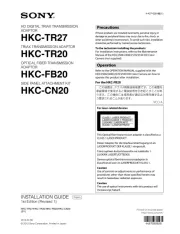
11 Augustus 2025
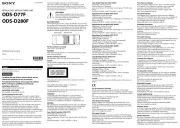
6 Augustus 2025
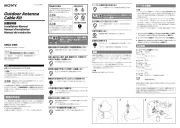
6 Augustus 2025
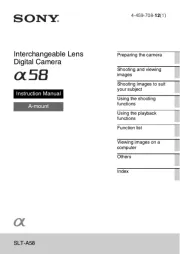
6 Augustus 2025
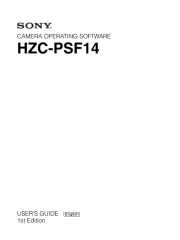
6 Augustus 2025
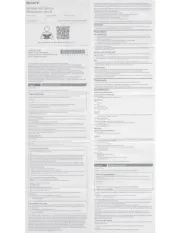
28 Juli 2025
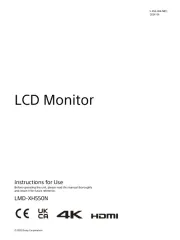
8 Juli 2025
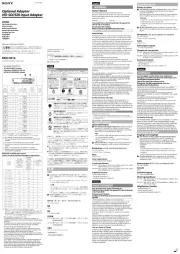
7 Juli 2025
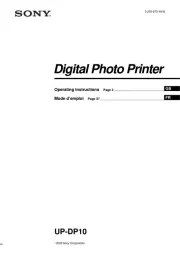
7 Juli 2025
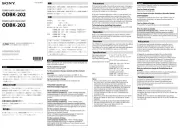
7 Juli 2025
Handleiding Niet gecategoriseerd
- Kica
- Parrot
- Mean Well
- Medeli
- Softron
- Indesit
- Bestron
- Exquisit
- Smart Strip
- DEERSYNC
- FXLab
- Nûby
- Daikin
- Tzumi
- Kupper
Nieuwste handleidingen voor Niet gecategoriseerd
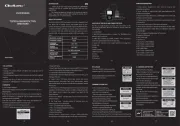
13 September 2025
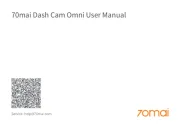
13 September 2025

13 September 2025
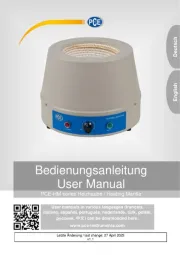
13 September 2025
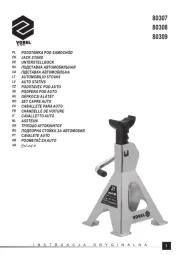
13 September 2025
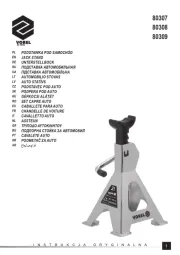
13 September 2025
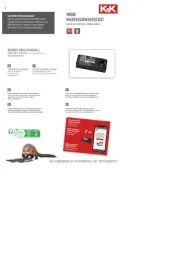
13 September 2025
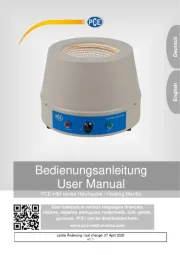
13 September 2025

13 September 2025
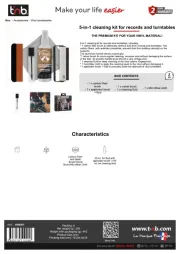
13 September 2025